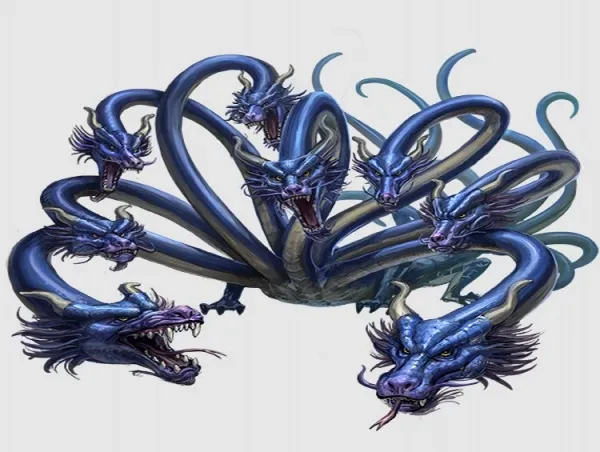
The world of Pathfinder is a world teaming with magic. Some of that magic gets into the makeup of the local flora and fauna. But as many adventurers will tell you, this isn’t always for the better. Whether the magic is psychologically corrosive or the beasts are simply antagonistic, sometimes a fight is inevitable.
10. Trollhounds
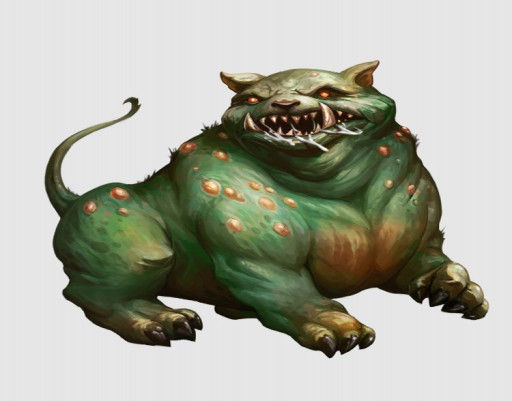
Usually seen with trolls, the trollhounds are low-level magical beasts. They can’t be tamed by other races and anyone who has tried has ended up with a big problem. Primarily because they breed like Tribbles.
That and the fact that they are rife with disease. The bloodfire fever is incredibly inconvenient, giving sufferers the enfeebled and clumsy status. While not deadly in and of itself, it can be a problem in the heat of battle.
Speaking of heat, Trollhounds have an amazingly annoying regeneration ability. They regenerate 15 HP per turn, even if they’re unconscious. Your party will need fire or acid attacks to end it.
Trollhound stats:
- Level 3
- Perception +6; darkvision, scent (imprecise) 30 feet
- Skills Acrobatics +6, Athletics +11, Stealth +8, Survival +6
- Str +4, Dex +1, Con +5, Int -4, Wis +1, Cha -2
- AC 17; Fort +14, Ref +8, Will +6
- HP 65, regeneration 15 (deactivated by acid or fire); Weaknesses fire 10
- Speed 35 feet
- Melee jaws +11 [+6/+1], Damage 1d12+4 piercing plus Knockdown and bloodfire fever
- Bloodfire Fever (disease) Saving Throw DC 18 Fortitude; Stage 1 carrier with no ill effect (1 day); Stage 2 enfeebled 1 (1 day); Stage 3 enfeebled 1 and clumsy 1 (1 day); Stage 4 enfeebled 2 and clumsy 2 (1 day); Stage 5 enfeebled 2, clumsy 2, and fatigued (1 day)
- Pack Attack The trollhound deals an extra 1d6 damage to any creature within reach of at least two of the trollhound's allies.
9. Werewolf
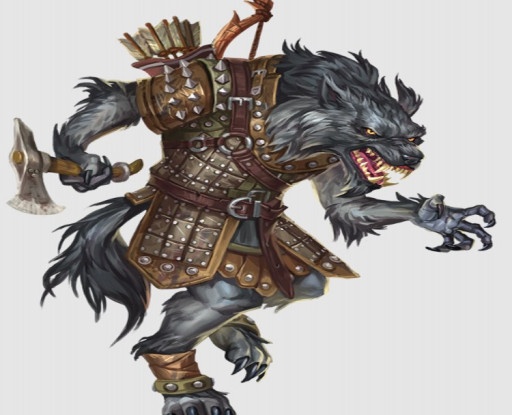
Cursed to transform every full moon, werewolves become vicious and controlled by their bloodlust. They will attack anything that moves. And the party falls under the category of “anything.”
Many werewolves will wield weapons like battleaxes. The bigger concern is the bite. Players can become victims of lycanthropy and become uncontrollable beasts during the full moon.
The thing that makes werewolves interesting is the mystery. Some people are evil and will come right out and say they’re werewolves. However, many do not know they’re cursed. This can create a mystery since players have to find who the werewolf is. There’s also an ethical dilemma since the werewolf isn’t responsible for their actions.
Werewolf stats:
- Level 3
- Perception +9; low-light vision, scent (imprecise) 30 feet
- Languages Common; wolf empathy
- Skills Acrobatics +7, Athletics +9, Survival +10
- Str +4, Dex +2, Con +2, Int -1, Wis +2, Cha +1
- Wolf Empathy (divination, primal) The werewolf can communicate with lupines.
- Items battle axe, composite shortbow (20 arrows), studded leather armor
- AC 19; Fort +11, Ref +9, Will +7
- HP 63; Weaknesses silver 5
- Attack of Opportunity
- Speed 25 feet
- Melee battle axe +11 [+6/+1] (sweep), Damage 1d8+8 slashing
- Melee claw +11 [+7/+3] (agile), Damage 1d6+8 slashing
- Melee jaws +11 [+6/+1], Damage 1d8+8 piercing plus curse of the werewolf
- Ranged composite shortbow +9 [+4/-1] (deadly 1d10, range increment 60 feet, reload 0), Damage 1d6+4 piercing
- Change Shape (concentrate, polymorph, primal, transmutation) Human with fist +11 for 1d4+8 bludgeoning, or wolf with Speed 40 feet and jaws with Knockdown.
- Curse of the Werewolf (curse, necromancy, primal) This curse affects only humanoids. Saving Throw DC 19 Fortitude save. On each full moon, the cursed creature must succeed at another Fortitude save or turn into a werewolf until dawn. The creature is under the GM’s control and goes on a rampage for half the night before falling unconscious until dawn.
- Moon Frenzy (polymorph, primal, transmutation) When a full moon appears in the night sky, the werewolf must enter hybrid form, can’t Change Shape thereafter, becomes one size larger, increases its reach by 5 feet, and increases the damage of its jaws by 2. When the moon sets or the sun rises, the werewolf returns to humanoid form and is fatigued for 2d4 hours.
- Pack Attack The werewolf’s Strikes deal 1d6 extra damage to creatures within reach of at least two of the werewolf’s allies.
8. Winter Wolf
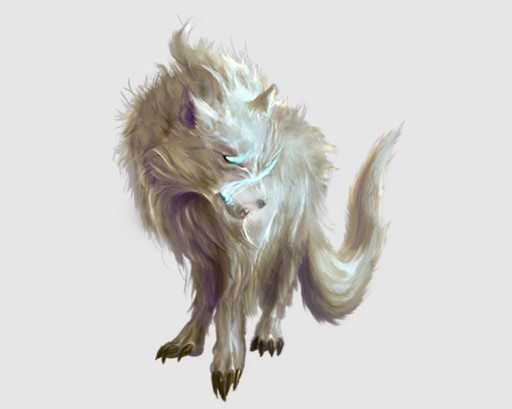
Winter Wolves are much bigger than the standard wolf. Usually, they serve no one but the strongest like frost dragons or white dragons. However, a Winter Wolf is still dangerous in its own right.
It is immune to cold and weak to fire to give it more magical attributes. Plus, it makes fire spells more useful since monsters often have fire resistance or immunity. The avenging bite ability lets it attack anyone that attacks its allies.
Most interestingly, it has its breath attack. It can breathe cold breath in a 15-foot cone. This attack does 5d8 damage. If there are a lot of Winter Wolves, this will become a massive problem.
Winter Wolf stats:
- Level 5
- Perception +14; darkvision, scent (imprecise) 30 feet
- Languages Common, Jotun
- Skills Acrobatics +13, Athletics +13, Deception +11, Intimidation +11, Stealth +13 (+16 in snow), Survival +12
- Str +6, Dex +4, Con +4, Int +2, Wis +3, Cha +2
- AC 23; Fort +13, Ref +15, Will +10
- HP 70; Immunities cold; Weaknesses fire 5
- Buck DC 21
- Avenging Bite Trigger A creature within reach of the winter wolf’s jaws attacks one of the winter wolf’s allies. Effect The winter wolf makes a jaws Strike against the triggering creature.
- Speed 40 feet
- Melee jaws +15 [+10/+5] (cold), Damage 1d10+6 piercing plus 1d6 cold and Knockdown
- Breath Weapon (cold, evocation, primal) The winter wolf breathes a cloud of frost in a 15-foot cone that deals 5d8 cold damage (DC 23 basic Reflex save). The winter wolf can’t use Breath Weapon again for 1d4 rounds.
- Pack Attack The winter wolf’s Strikes deal 1d6 extra damage to creatures within the reach of at least two of the winter wolf’s allies.
7. Hell Hound
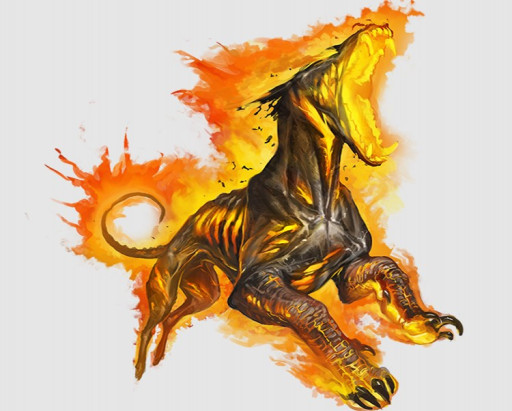
On the opposite elemental end from the Winter Wolf, there’s the Hell Hound. These dogs wrapped in fire are more terrifying than adorable. The party will often find them in the services of various more intelligent demons or Hell Knights hunting fugitives.
They have strong jaws as do most canines. They’re also immune to fire but weak to cold. In fact, they draw strength from fire. This can make them a big problem.
They have a fire breath attack that can deal damage in a 15-foot cone. Traditionally, breath attacks take a few rounds to recharge. However, this restriction is lifted when a Hell Hound gets hit with another fire attack. And Hell Hounds frequently hang out with fire-using creatures.
Hell Hound stats:
- Level 3
- Perception +9; darkvision, scent (imprecise) 60 feet
- Languages Infernal; (can’t speak any language)
- Skills Acrobatics +8, Athletics +9, Stealth +8, Survival +9 (+11 to Track)
- Str +4, Dex +3, Con +2, Int -2, Wis +2, Cha -2
- AC 19; Fort +9, Ref +10, Will +7
- HP 40; Immunities fire; Weaknesses cold 5
- Speed 40 feet
- Melee jaws +13 [+8/+3] (magical), Damage 1d8+4 piercing plus 1d6 evil and 1d6 fire
- Breath Weapon (divine, evocation, fire) The hell hound breathes flames that deal 4d6 fire damage to all creatures in a 15-foot cone (DC 19 basic Reflex save). The hell hound can’t use Breath Weapon again for 1d4 rounds. If the hell hound would take fire damage or be targeted by a fire effect, its Breath Weapon recharges.
6. Hellcats
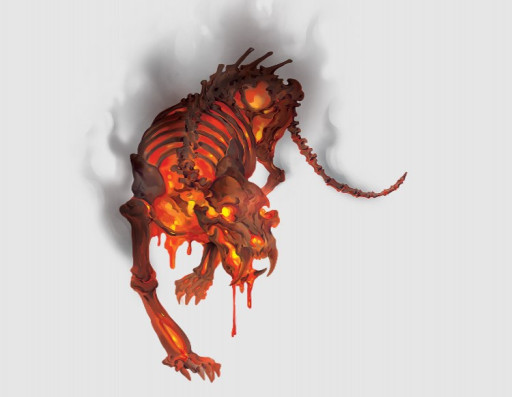
Players should not try to compare Hellcats to Hell Hounds. Much more intelligent and easier to insult, these cats are powerful opponents. And they hold grudges.
Defensively, Hellcats are strong. While they don’t absorb fire, they do resist it. They resist 10 physical damage, which can become a problem for fighters. When working with other Hellcats, they can’t be flanked, creating issues for characters that rely on sneak attacks.
Hellcats have the ability to inflict the frightened status with their menacing growl. Anyone who is frightened takes additional damage from their attacks. And you have to get a critical success to be immune to menacing growl for 24 hours. Add in the fact that they attack in packs, this fight can be challenging.
Hellcat stats:
- Level 7
- Perception +16; darkvision, scent (imprecise) 30 feet
- Languages Infernal; can't speak any language, telepathy 100 feet
- Skills Acrobatics +17, Athletics +17, Intimidation +14, Stealth +17, Survival +14
- Str +6, Dex +4, Con +4, Int +0, Wis +3, Cha +1
- AC 25; Fort +15, Ref +17, Will +12; +1 status to all saves vs. magic
- HP 110; Resistances fire 10, physical 5 (except silver); Weaknesses good 5
- Fade into the Light (divine, illusion) Trigger The hellcat begins its turn in bright light; Effect The hellcat becomes invisible until its no longer in bright light. If the hellcat uses a hostile action, the invisibility ends after that hostile action is completed.
- Speed 35 feet
- Melee jaws +18 [+13/+8], Damage 2d12+7 piercing
- Melee claw +18 [+14/+10] (agile), Damage 2d8+7 slashing
- Fearful Attack The hellcat deals an additional 1d6 precision damage to frightened creatures.
- Infernal Mindlink (concentrate, divine, divination) The hellcat telepathically link its senses to all other hellcats within 100 feet for 10 minutes. It loses this contact with any hellcat that moves out of a 100-foot radius. While linked to at least one ally, the hellcat can't be flanked and gains a +2 status bonus to Will saving throws.
- Menacing Growl (auditory, emotion, fear, mental) The hellcat produces a low growl to disorient and frighten foes. The hellcat can cause this vocalization to originate from somewhere else within 30 feet. Non-fiends in a 15-foot burst must attempt a DC 25 Will save. The hellcat can't issue another Menacing Growl for 1d4 rounds.
- Critical Success The creature is unaffected and is temporarily immune for 24 hours.
- Success The creature is frightened 1.
- Failure The creature is frightened 2.
- Critical Failure The creature is frightened 4.
- Pounce The hellcat Strides and makes a Strike at the end of that movement. If the hellcat began this action hidden, it remains hidden until after the ability's Strike.
5. Mukradi
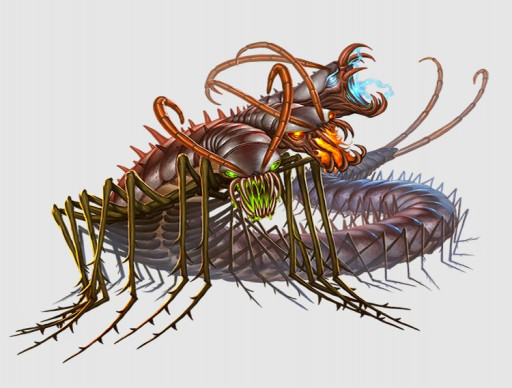
Some believe Mukradi were conceived in the nightmares of a demigod. While only a rumor, fighting an enraged Mukradi can be nightmarish. Particularly if the party is relying on elemental resistances to help them.
The Mukradi have strong defenses. It has strong natural armor. It has resistances to acid, fire and electricity damage. And if a player tries to inflict, slow, confusion, paralysis, or stunning effects, a Mukradi can divert it to one of its heads instead.
Speaking of their heads, their heads each have their own type of elemental damage. Each bite attack inflicts additional damage. Mukradi’s heads also have their own breath attacks with different ranges. And getting hit with a critical attack recharges them and lets them use their breath attack as a reaction.
Mukradi stats:
- Level 15
- Perception +24; darkvision, tremorsense (imprecise) 60 feet
- Skills Athletics +32
- Str +9, Dex +0, Con +7, Int -3, Wis +3, Cha +0
- AC 37 all-around vision; Fort +32, Ref +23, Will +26
- HP 300; Resistances acid 20, electricity 20, fire 20
- Partitioned Anatomy Trigger The mukradi would be confused, paralyzed, slowed, or stunned. Effect The mukradi confines the debilitating effect to a certain portion of its nervous system, ignoring the effect but causing a maw of its choice to go dormant for the effect’s duration. That maw can’t be used for a Strike or Breath Weapon during that time. This ability can’t be used if all the mukradi’s heads are dormant.
- Spitting Rage Trigger A creature scores a critical hit on the mukradi. Effect The mukradi’s Breath Weapon recharges. It can use its Breath Weapon immediately as part of this reaction. It can't use this reaction again until it recharges its Breath Weapon naturally.
- Speed 60 feet, burrow 60 feet, climb 60 feet
- Melee acid maw +32 [+27/+22] (magical, reach 20 feet), Damage 2d12+17 piercing plus 3d6 acid
- Melee flame maw +32 [+27/+22] (magical, reach 20 feet), Damage 2d12+17 piercing plus 3d6 fire
- Melee shock maw +32 [+27/+22] (magical, reach 20 feet), Damage 2d12+17 piercing plus 3d6 electricity
- Melee leg +32 [+28/+24] (agile, magical, reach 15 feet), Damage 2d10+17 piercing
- Melee tail lash +32 [+27/+22] (magical, reach 30 feet), Damage 3d10+17 slashing plus Knockdown
- Breath Weapon (evocation, primal) The mukradi breathes a blast of energy from one of its three heads; each creature in the area must attempt a DC 36 basic Reflex save. The mukradi can’t use Breath Weapon again for 1d4 rounds
- .Acid Maw (acid) 10-foot-wide, 60-foot line of acid dealing 16d6 acid damage.
- Flame Maw (fire) 60-foot cone of fire dealing 16d6 fire damage.
- Shock Maw (electricity) 120-foot line of electricity dealing 16d6 electricity damage.
- Pull Apart The mukradi makes two Strikes with different maws against the same target. If both hit, the target takes an extra 2d12+13 slashing damage, with a DC 36 basic Fortitude save. On a critical failure, the creature is torn to pieces and dies. The mukradi's multiple attack penalty increases only after all the attacks are made.
- Thrash The mukradi Strikes once against each creature in its reach. It can Strike up to once with each maw, once with its tail lash, and any number of times with its legs. Each attack takes a –2 circumstance penalty and counts toward the mukradi's multiple attack penalty, but the multiple attack penalty doesn’t increase until after all the attacks are made.
- Trample Huge or smaller, leg, DC 36
4. Gorgon
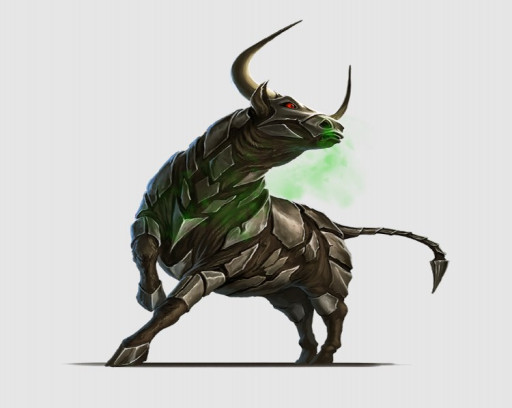
As far as mid-level magical beasts go, the Gorgon is one of the most brutal. Any party that faces these creatures is at risk of permanent death. Particularly if the GM is playing on hard mode.
By themselves, Gorgons don’t seem like much of a threat. They look like stone bulls and have traditional goring and trampling attacks. But the real danger is its petrifying breath.
You have to get a critical success to not be affected. A regular success means you’re slowed. Failure means you’re petrified for a minute or permanently. If the GM is playing hard mode, he might have the Gorgon smash the petrified character. And there’s no immunity after succeeding against the petrifying breath. So if there are multiple Gorgons, you could have to make multiple saves.
Gorgon stats:
- Level 8
- Perception +19; darkvision, scent (imprecise) 30 feet
- Skills Athletics +19
- Str +7, Dex +3, Con +6, Int -4, Wis +5, Cha +3
- AC 28; Fort +18, Ref +13, Will +17
- HP 135; Immunities petrification
- Speed 25 feet
- Melee horn +20 [+15/+10], Damage 2d12+10 piercing
- Melee hoof +18 [+13/+8], Damage 2d6+10 bludgeoning
- Breath Weapon (earth, incapacitation, primal, transmutation) The gorgon breathes a 60-foot cone of green gas. Each creature in the area must attempt a DC 25 Fortitude save. The gorgon can't use Breath Weapon again for 1d4 rounds.
- Critical Success The creature is unaffected.
- Success The creature's body hardens and stiffens, causing it to become slowed 1 for 1 round.
- Failure The creature becomes petrified for 1 minute. It can attempt a new save at the end of each of its turns.
- Critical Failure The creature becomes petrified permanently.
- Powerful Charge The gorgon Strides twice, then makes a horn Strike. If it moved at least 20 feet from its starting position, the Strike's damage is increased to 3d12+12.
- Trample Medium or smaller, hoof, DC 26
3. Grootslang
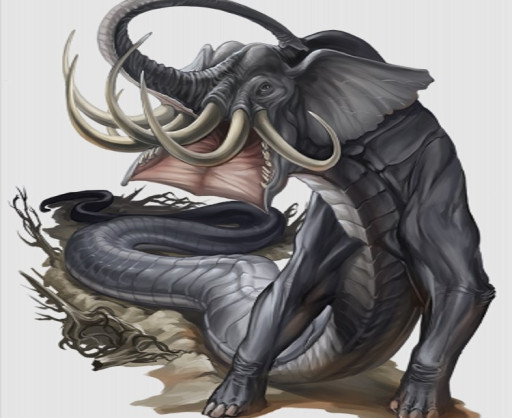
These elephant-like creatures were rumored to be created as a prank by a god. Unfortunately, the prank has gotten out of control. These malicious creatures now roam the jungle eating and killing anyone who doesn’t pay them proper tribute. And even the ones who do.
Being snakes with elephant heads, these monsters can constrict players and choke the life out of them. They can also coil themselves to give themselves resistance to physical damage.
Being quite large, they can swallow people whole. They also have a long reach with all their attacks. Their basic attacks have 15-30 feet depending on the limb. And they have attacks of opportunity. If all fails, they’ll retreat to the water and teleport to another body of water.
Grootslang Stats:
- Level 16
- Perception +28; darkvision, scent (imprecise) 60 feet
- Languages Aquan, Draconic, Mwangi
- Skills Athletics +34, Intimidation +28, Nature +26, Stealth +23
- Str +9, Dex +5, Con +8, Int +5, Wis +6, Cha +0
- Deep Breath A grootslang can hold its breath for 1 hour.
- AC 38; Fort +30, Ref +27, Will +26
- HP 370
- Attack of Opportunity
- Speed 40 feet, swim 30 feet
- Melee foot +30 [+25/+20] (magical, reach 20 feet), Damage 3d12+15 bludgeoning
- Melee jaws +28 [+24/+20] (agile, magical, reach 15 feet), Damage 3d10+15 piercing plus Improved Grab
- Melee tail +28 [+24/+20] (agile, magical, reach 30 feet), Damage 3d10+15 bludgeoning plus Grab
- Melee tusk +30 [+25/+20] (magical, reach 20 feet), Damage 3d12+15 piercing
- Aquatic Elusion (concentrate, conjuration, teleportation, primal) Requirements The grootslang is fully immersed in water; Effect The grootslang teleports to another body of water within 1 mile that is wide enough to hold the grootslang.
- Defensive Coil The grootslang coils its body. It gains 20 resistance against physical attacks until the start of its next turn.
- Greater Constrict tail only, 2d12+12 bludgeoning, DC 34
- Swallow Whole jaws only, Huge, 3d12+10 bludgeoning, Rupture 37
- Thunderous Slam The grootslang makes a foot Strike against a creature in reach. Whether or not the Strike hits, all creatures within 10 feet of the grootslang must attempt a DC 37 Reflex save.
- Critical Success The creature is unaffected.
- Success The creature is flat-footed until the end of its turn.
- Failure The creature is knocked prone and takes 2d8 bludgeoning damage.
- Critical Failure As failure, except the creature takes 4d8 bludgeoning damage.
2. Orochi
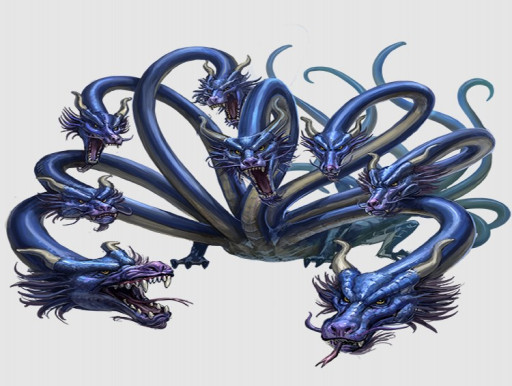
Indiana Jones would hate this monster. This multiple-headed snake monster swallows everything it touches. It also has some extremely powerful defenses.
Its biggest defense is that it’s immune to area-of-effect damage. This can be a problem if your party relies on casters doing a lot of area-of-effect damage. It also has all-around vision which can be a problem for rogues and others that rely on flanking.
Offensively, Orochis are brutal. They can attack multiple people with their multiple heads. They can also attack the same person in an attack of opportunity if they cross multiple squares where attacks are possible. Which is easy with their large size and long reach. Each head has 60 HP so they can be cut off.
Orochi stats:
- Level 18
- Perception +33; darkvision, low-light vision
- Languages Aklo, Common, Draconic
- Skills Acrobatics +30, Athletics +36, Intimidation +31, Survival +29
- Str +10, Dex +6, Con +10, Int +5, Wis +4, Cha +6
- AC 42 all-around vision; Fort +33, Ref +30, Will +27
- HP 400 ((body) ; Resistances poison 15
- HP (head) 60, multiple heads ); Immunities area damage; Resistances poison 15; Weaknesses cold iron 15
- Frightful Presence (aura, emotion, fear, mental) 60 feet, DC 37
- Attack of Opportunity
- Multiple Heads A creature can attempt to sever one of the orochi's eight heads by specifically targeting it and dealing damage equal to the head's HP. A head not completely severed returns to full HP at the end of the attacking creature's turn. An orochi that loses all of their heads immediately dies.
- Multiple Opportunities The orochi gains an extra reaction per round for each of their heads that remains beyond the first, which it can use only to make Attacks of Opportunity. They can't use more than 1 reaction on the same triggering action, and the orochi must use a different head for each Attack of Opportunity.
- Speed 30 feet, swim 60 feet
- Melee jaws +35 [+30/+25] (reach 40 feet), Damage 3d12+18 piercing plus Improved Grab
- Melee tail +35 [+31/+27] (agile, magical, reach 50 feet), Damage 3d10+18 bludgeoning plus Improved Knockdown
- Ranged rock +34 [+29/+24] (brutal, range increment 100 feet), Damage 3d8+18 bludgeoning
- Orochi Flurry The orochi makes a number of jaws Strikes equal to the number of their remaining heads, each against a different target. The orochi's multiple attack penalty doesn't increase until after the orochi makes all of their attacks.
- Swallow Whole (attack) Huge, 2d12+18 bludgeoning, Rupture 40
1, Kothogaz, Dance of Disharmony
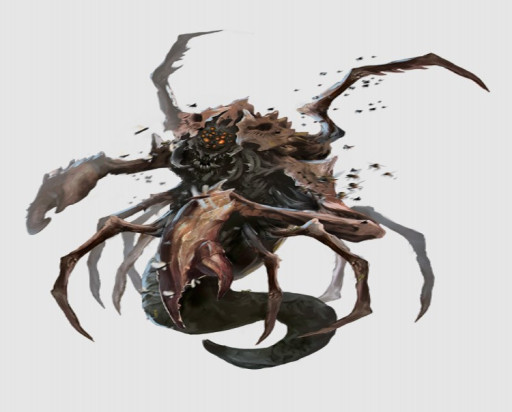
As far as magical beast boss monsters, you can’t do much better than Kothogaz, Dance of Disharmony. This horrifying creature has many abilities, both offensive and defensive. A fight with Kothogaz will be brutal.
For starters, Kothogaz is immune to most of the best control spells like paralysis. Its aura can give players the sickened status. Getting within striking distance is a problem. Its heartbeat inspires fear and compels anyone within 120 feet to start What also doesn’t help is that Kothogaz regenerates 40 HP every turn.
Kothogaz spreads disease wherever he goes. Kothogaz’s bites gradually turn people into undead. Its pox the land ability creates a volcano of filth that can do immense amounts of damage. And any squares Kothogaz travels through become contaminated. Also, he can swallow characters whole.
Kothogaz stats
Level 21
- Perception +41; darkvision, scent (imprecise) 120 feet
- Languages Aklo; (can't speak any language)
- Skills Acrobatics +43, Athletics +41, Stealth +35
- Str +10, Dex +10, Con +9, Int -3, Wis +8, Cha +6
- AC 49; Fort +32, Ref +39, Will +35
- HP 400, regeneration 30; Immunities acid, clumsy, disease, drained, enfeebled, mental, paralyzed, petrified, poison, polymorph, stupefied; Resistances sonic 20
- Frightful Presence (aura, emotion, fear, mental) 300 feet, DC 41
- Horrific Speed Kothogaz is permanently quickened 1. It can use this extra action to Stride or Strike.
- Noxious Aura (aura, poison) 120 feet. A creature that enters or begins its turn in the emanation must succeed at a DC 41 Fortitude save or be sickened 2 (sickened 3 on a critical failure).
- Reactive Kothogaz gains 3 reactions each round.
- Tympanic Heartbeat (aura, auditory) 120 feet. Kothogaz's heartbeat booms like a deity's drum. A creature that enters or begins its turn in the emanation must attempt a DC 41 Will save. On a failure, its next two actions must be move actions to move at least half its Speed away from Kothogaz. A creature that critically succeeds is temporarily immune to tympanic heartbeat for 1 minute.
- Attack of Opportunity
- Speed 80 feet, fly 60 feet, swim 60 feet
- Melee jaws +39 [+34/+29] (reach 20 feet, versatile B), Damage 4d8+18 piercing plus 2d12 sonic plus many-eyed blight
- Melee claw +39 [+35/+31] (agile, reach 20 feet, versatile B), Damage 4d6+18 slashing plus 2d6 acid and Improved Grab
- Ranged bezoar +39 [+34/+29] (range increment 100 feet), Damage 4d8+8 bludgeoning plus 2d6 acid and many-eyed blight
- Disharmonic Door (teleportation) Kothogaz disappears, then bursts as a cacophonous sound from the throat of a creature within 240 feet. Kothogaz appears within reach of the creature and makes a melee Strike against it. The Strike deals an additional 2d12 sonic damage.
- Many-Eyed Blight (disease, virulent) DC 44 Fortitude; Stage 1 stupefied 2; Stage 2 stupefied 2 and dazzled; Stage 3 stupefied 3, confused, and blinded; Stage 4 if you die, at the next new moon, your body splits, and your viscera become an undead under Kothogaz's control.
- Pox the Land (poison, transmutation) Kothogaz raises a pustule from the ground within 120 feet, which erupts in a 10-foot radius, 200-foot-high cylinder of cloying filth. Creatures in the area must succeed at a DC 44 basic Reflex save or take 6d10 poison damage. On a failure, they can't fly for 1 round (1 minute on a critical failure); flying creatures fall safely to the ground.
- Suppurating Passage The earth festers in Kothogaz's wake. Kothogaz Strides up to its Speed. Squares through which Kothogaz passes are greater difficult terrain until the start of its next turn, and any creature that enters or begins its turn in those squares must succeed at a DC 44 Reflex save or take 4d10 poison damage and 4d10 acid damage (on a critical failure, double damage and exposed to many-eyed blight).
- Swallow Whole (attack) Huge, 4d10+18 bludgeoning plus 2d12 sonic and clumsy 1 while swallowed, Rupture 40
